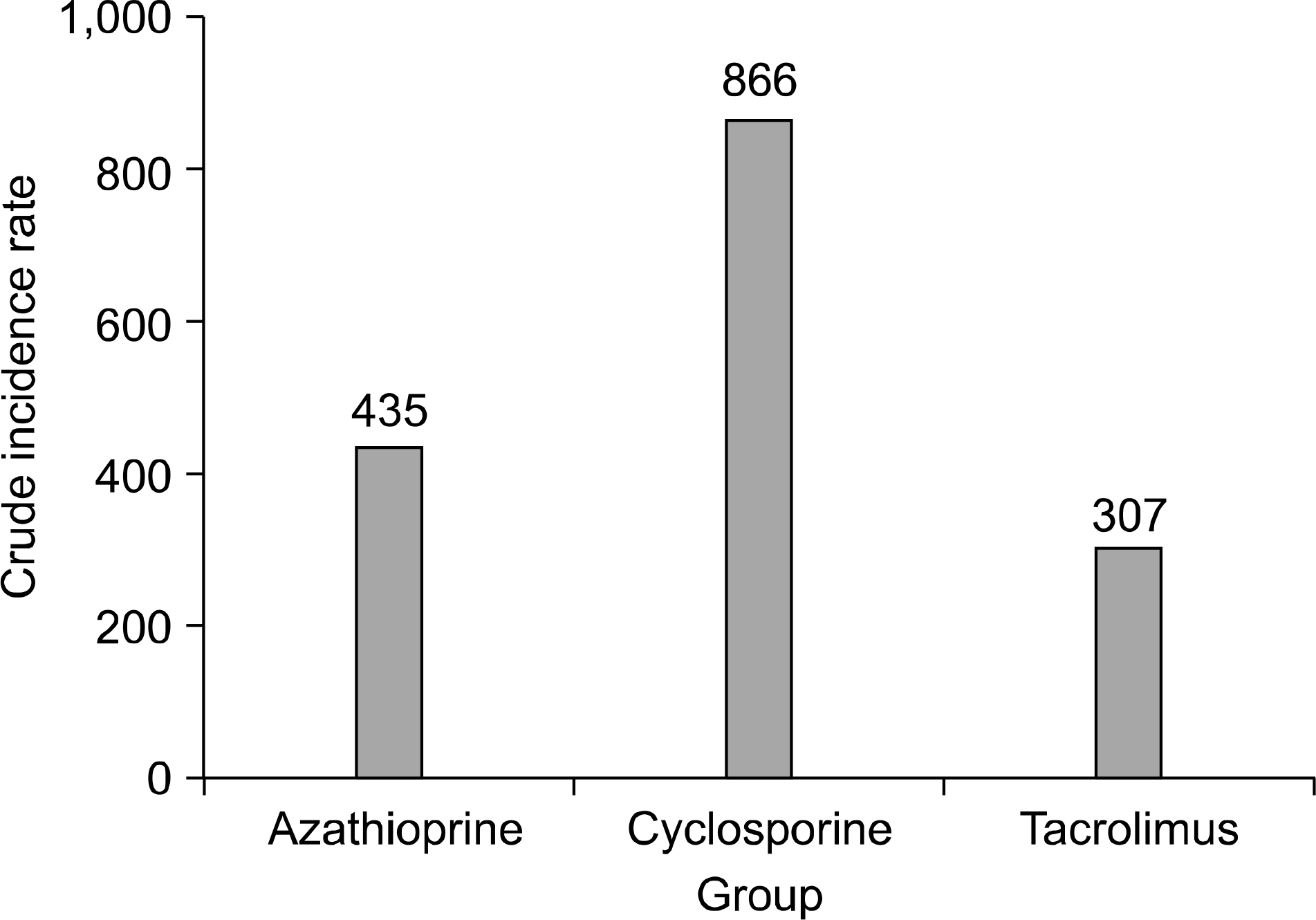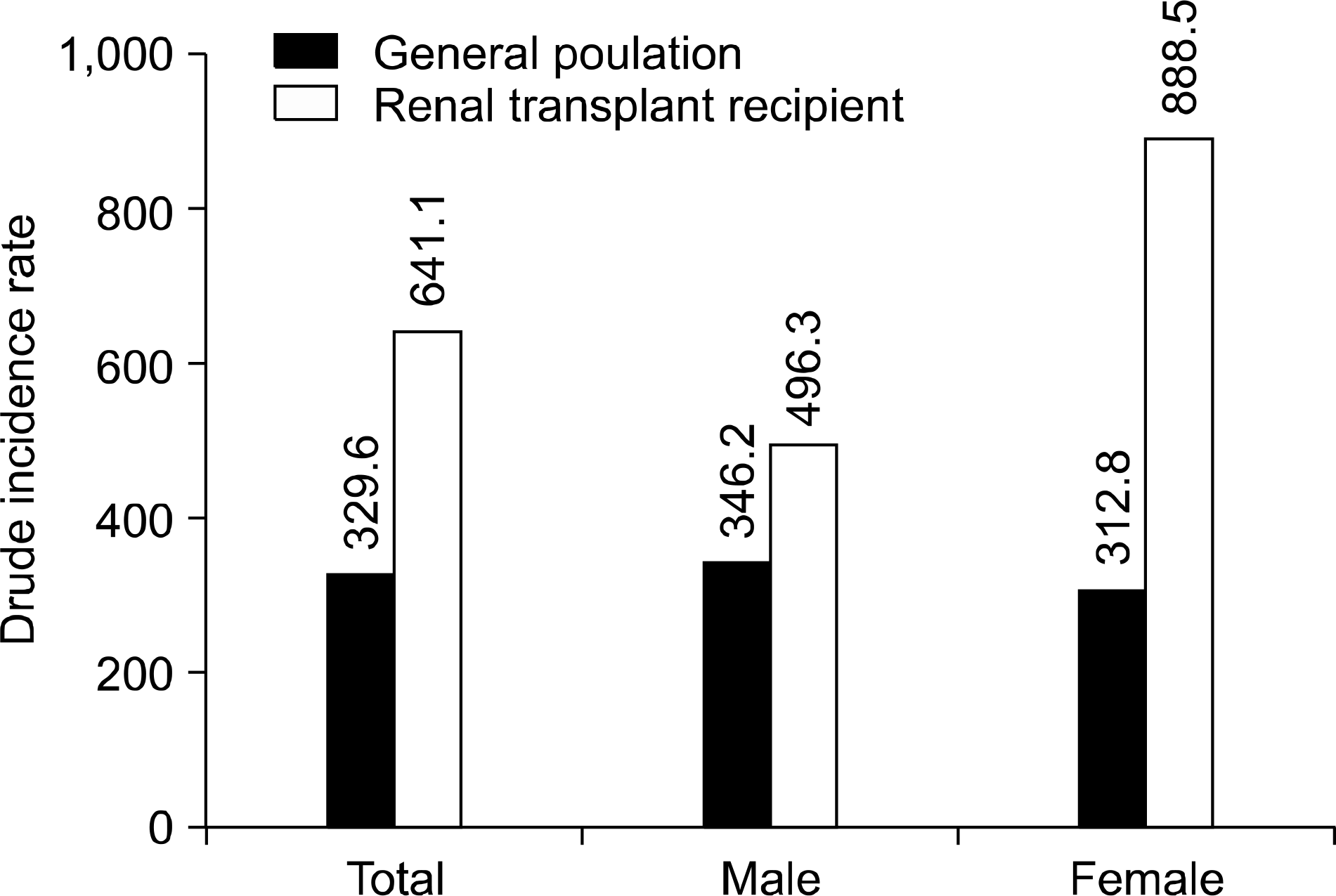Abstract
Background
The incidence pattern of malignancy after kidney transplantation is different from that of the general population. Because increased exposure to immunosuppressants results in an increased incidence of malignancy, institutional reports that do not consider duration of immunosuppression have limited value for providing future kidney recipients with the actual risk for malignancy or for developing a kidney allograft recipient surveillance program. Thus, we retrospectively analyzed our institutional data with regard to the duration of exposure to immunosuppressants.
Methods
A total of 757 patients who had kidney transplantation and were followed-up for at least 6 months at our hospital were reviewed retrospectively. The crude incidence rate (CI) was calculated by counting the days of exposure to immunosuppressants.
Results
Most malignancies after kidney transplantation were solid tumors (85.3%). The CI of malignancies was 641.1 in allograft recipients and 329.6 in the general population per 100,000 persons per year. Solid tumor cancers of the stomach, liver, lung, breast, cervix, and pancreas showed an increased CI in the allograft recipient group than the general population but cancers of the thyroid and colon did not. Based on the type of immunosuppressive agent, the CI was highest in the cyclosporine group (866/12 months/100,000 persons) than the other groups.
Conclusions
We have provided the CIs of cancers after kidney transplantation at our institute. The pattern of post-transplant malignancy is different from that of western countries. Nationwide registration is needed to provide a more rational approach to post-transplant cancer surveillance in Korea.
Go to : 
References
1). Adami J, Gäbel H, Lindelöf B, Ekström K, Rydh B, Glimelius B, et al. Cancer risk following organ transplantation: a nationwide cohort study in Sweden. Br J Cancer. 2003; 89:1221–7.

2). Kasiske BL, Snyder JJ, Gilbertson DT, Wang C. Cancer after kidney transplantation in the United States. Am J Transplant. 2004; 4:905–13.

3). Vajdic CM, McDonald SP, McCredie MR, van Leeuwen MT, Stewart JH, Law M, et al. Cancer incidence before and after kidney transplantation. JAMA. 2006; 296:2823–31.

4). Kong JM. Malignancy in renal transplant recipients. J Korean Soc Transplant. 2009; 23:130–4. (공진민. 신장이식 환자의 악성종양. 대한이식학회지 2009;23: 130–4.).

5). Kim SS, Min SK, Huh S, Jung IM, Ha JW, Ahn CR, et al. Malignancy in renal transplant recipient. J Korean Soc Transplant. 1999; 13:133–9. (김성수, 민승기, 허승, 정인목, 하종원, 안규리, 등. 신이식 후 발생한 악성종양. 대한이식학회지 1999;13: 133–9.).
6). Kim GH, Choi JH, Jeong JH. Malignancy in renal transplant recipients. J Korean Soc Transplant. 2002; 16:215–8. (김근환, 최재호, 정준헌. 신이식 후 발생한 악성종양. 대한이식학회지 2002;16: 215–8.).

7). Kim MJ, Kim HJ. Prevalence of cancers in korean recipients of renal transplant. Korean J Nephrol. 2002; 21:367–74. (김명재, 김희진. 한국인의 신 이식 후 암 발생빈도. 대한신장학회지 2002;21: 367–74.).
8). Kim JY, Kim SH, Kim YS, Choi BS, Kim JC, Park SC, et al. Report of 1,500 kidney transplants at the Catholic University Of Korea. J Korean Soc Transplant. 2006; 20:172–80. (김진영, 김수현, 김영수, 최범순, 김준철, 박순철, 등. 톨릭대학교 의과대학에서 시행한 신장이식 1,500예의 성적보고. 대한이식학회지 2006;20: 172–80.).
9). Ro H, Kim SM, Kim KW, Hwang YH, Yang JS, Oh KH, et al. Malignancy after kidney transplantation. J Korean Soc Transplant. 2006; 20:187–92. (노한, 김선문, 김기원, 황영환, 양재석, 오국환, 등. 신이식 후 발생한 악성종양: 단일기관에서의 37년 발생양상 분석. 대한이식학회지 2006;20: 187–92.).
10). Buell JF, Gross TG, Woodle ES. Malignancy after transplantation. Transplantation. 2005; 80(2 Suppl):S254–64.

11). Mazuecos A, Muñoz Terol JM, García Alvárez T, Sola E, Rodríguez Benot A, Dsuna A, et al. Increase in malignancies as cause of death in renal transplant patients. Transplant Proc. 2009; 41:2159–62.

12). Park SH, Cho JH, Jang MH, Shin YB, Cho YJ, Kim JC, et al. Malignancy following renal transplantation. J Korean Soc Transplant. 2000; 14:81–6. (박선희, 조지형, 장민화, 신용봉, 조영준, 김준철, 등. 신이식 후에 발생한 악성종양. 대한이식학회지 2000;14: 81–6.).
13). van Leeuwen MT, Webster AC, McCredie MR, Stewart JH, McDonald SP, Amin J, et al. Effect of reduced immunosuppression after kidney transplant failure on risk of cancer: population based retrospective cohort study. BMJ. 2010; 340:c570.

14). Webster AC, Woodroffe RC, Taylor RS, Chapman JR, Craig JC. Tacrolimus versus ciclosporin as primary immunosuppression for kidney transplant recipients: meta-analysis and meta-regression of randomised trial data. BMJ. 2005; 331:810.

15). Kauffman HM, Cherikh WS, Cheng Y, Hanto DW, Kahan BD. Maintenance immunosuppression with tar-get-of-rapamycin inhibitors is associated with a reduced incidence of de novo malignancies. Transplantation. 2005; 80:883–9.

16). Bang BK. Malignancy in renal transplant recipients. Korean J Nephrol. 2006; 25:S497–503. (방병기. 신장이식 환자에서 암의 발생. 대한신장학회지 2006;25: s497-s503.).
17). Campistol JM. Minimizing the risk of posttransplant malignancy. Transplantation. 2009; 87(8 Suppl):S19–22.

18). Webster AC, Craig JC, Simpson JM, Jones MP, Chapman JR. Identifying high risk groups and quantifying absolute risk of cancer after kidney transplantation: a cohort study of 15,183 recipients. Am J Transplant. 2007; 7:2140–51.
Go to : 
 | Fig. 2.Crude incidence rate according to immunosuppressive agents (number/12 months/100,000 population). |
Table 1.
Demographics of study population
Table 2.
Numbers of malignancies among 757 kidney allograft recipients and their crude incidence rates
| N (%) | Transplanted patient (n=34) | General Populationb | |
|---|---|---|---|
| Gastric cancer | 7 (20.6) | 132.0 | 52.7 |
| Hepatocellular carcinoma | 6 (17.6) | 113.1 | 30.4 |
| Cervical cancer | 4 (11.7) | 221.4 | 14.8 |
| Lung cancer | 3 (8.7) | 56.6 | 36.3 |
| Breast cancer | 2 (5.8) | 110.7 | 47.4 |
| Renal cell carcinoma | 2 (5.8) | 43.7 | 5.8 |
| Thyroid cancer | 1 (2.9) | 18.9 | 43.1 |
| Pancreascancer | 1 (2.9) | 18.9 | 8.0 |
| Lymphoma a | 4 (11.7) | 76.6 | 6.6 |
| Multiple myeloma | 1 (2.9) | 7.7 | 1.4 |
| Skin cancer | 1 (2.9) | 11.1 | – |
| Ependymoma | 1 (2.9) | 24.8 | – |
| Metastatic lung cancer | 1 (2.9) | 61.3 | – |




 PDF
PDF ePub
ePub Citation
Citation Print
Print



 XML Download
XML Download